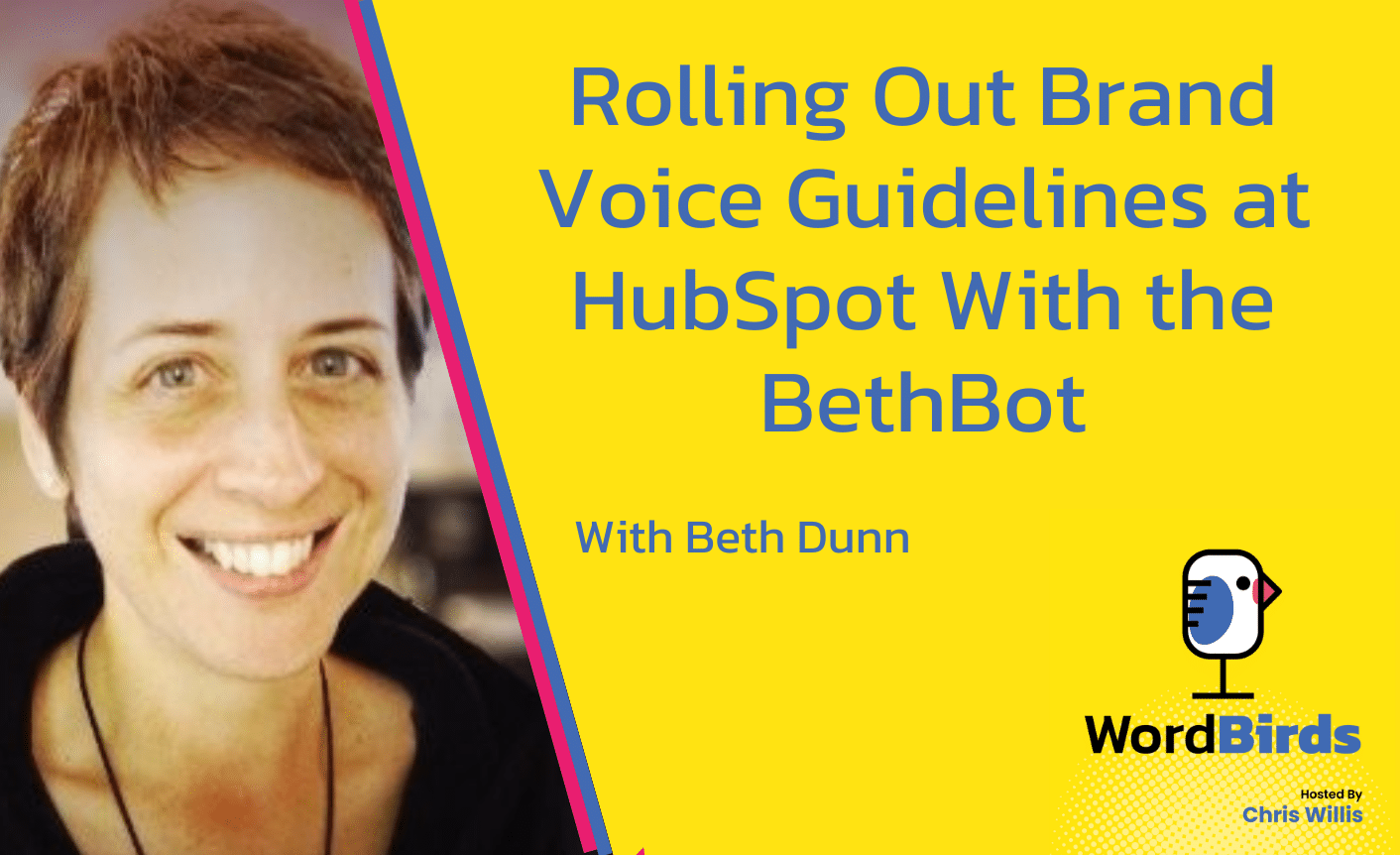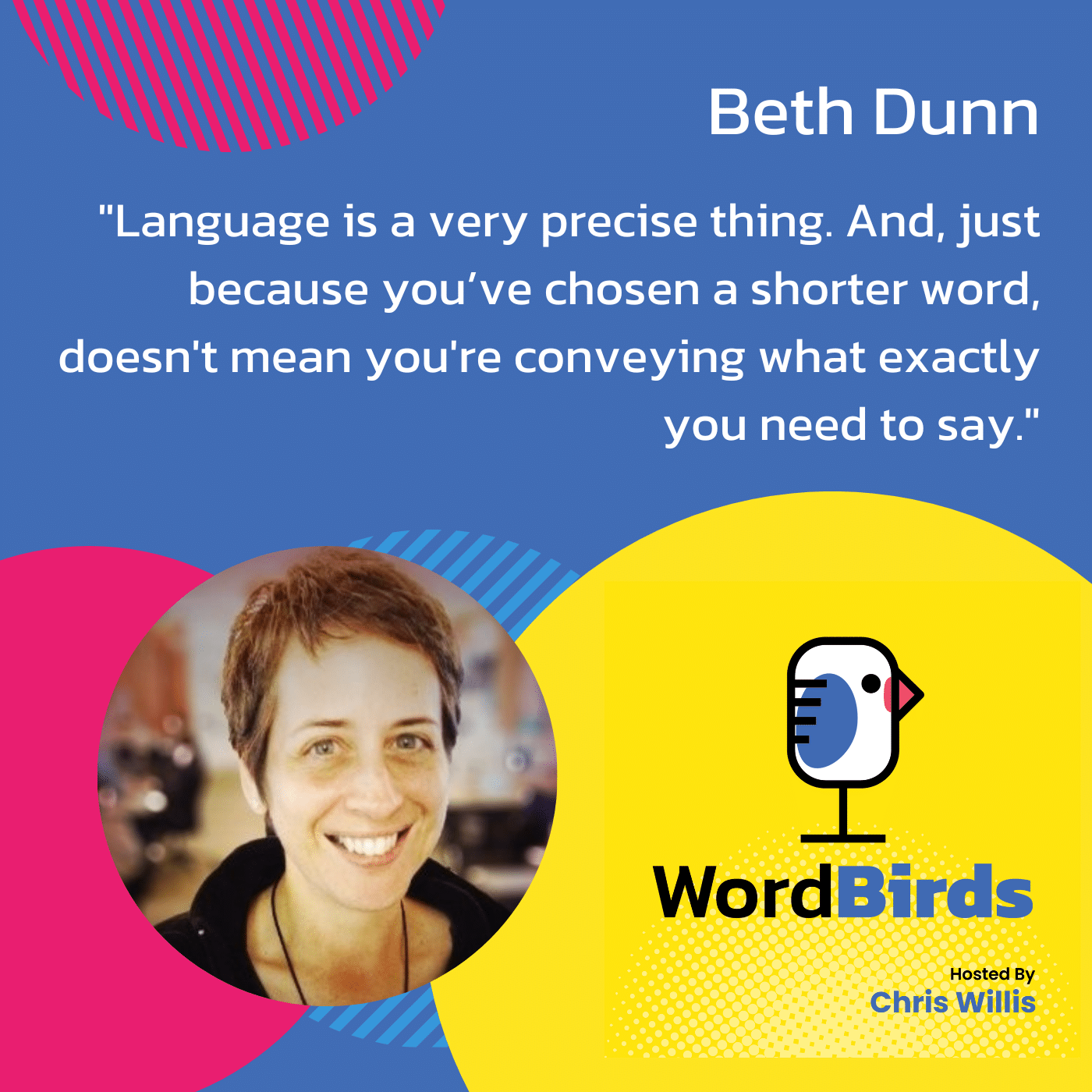
Beth Dunn, Head of Product Content at Practice Better and Founder of Product Content Advisors, joins us this week to discuss why brand voice guidelines can’t just sit with marketing.
A strong consistent brand voice is what makes some companies stand out from the crowd. If you have a strong brand identity that’s present at every content touchpoint, from social media posts to customer service documentation, you build a relationship with your target audience.
The challenge isn’t necessarily defining and creating your brand voice, but actually governing it across an organization. Beth overcame this challenge with the invention of the BethBot — an application that helps team members consistently use their brand’s tone in writing. You can learn all about how Beth created the BethBot at HubSpot in this week’s episode.
And are shorter words always better? Beth doesn’t think so. Find out why you shouldn’t sacrifice clarity for the sake of brevity in our “Provocative Statement of the Day” segment. Tune in below!
Watch the episode
Listen to the episode
Read the full episode transcript
Hello Beth and welcome to the show.
Thank you so much for having me. I’m delighted to be here.
I’m excited for you to be here. Let’s go ahead and jump right into the quick fire questions.
Amazing content is …
Amazing content is content that meets the user where they are, with what they need at the time that they need it.
Concise or descriptive?
False choice.
Go on.
That’s a false choice. You can be concise and descriptive at the same time. Why do you think poets make such great content designers?
Wow, fantastic. The company with the best brand voice is …
I’m not going to say best, but one company that I’ve been loving right now is Roger + Chris,
which is a furniture store. They’ve just got an amazing brand voice and tone and it’s in everything they do.
Best piece of content advice?
Keep trying.
And finally, when I’m creating content, I always …
Revise.
Fantastic. I want to go back to the brand voice. I think that’s interesting. So a furniture company. What do they do? How do they do it?
So full disclosure, I did order a sofa from Roger + Chris.
So it worked!
Yeah, it absolutely worked. But I will say that it didn’t hit me head on with the brand voice and tone, like a lot of us do. I think sometimes, like “We’re voice-y!” It was just the stuff that I wanted, it was the style that I wanted to look at. And then as I got deeper in, I started noticing little bits of quirk here and there. They didn’t get in my way with a lot of quirk upfront.
But in the emails and then in the educational videos that were helping me decide is velvet right for me, there was just a personality and an ethos there. And then as you scroll through their website and look at the fine print, you start to see the pattern. I just thought it was so interesting and so well executed that it was across all of their different channels.
I will say there's one caveat to this and the answer is the right word is never utilized. Never. It's always used. Share on XI started following them on social. So really paying attention to the emails they sent both before and after the transaction. Those are important to me. I really try to see where the veil is that you walk through. There’s almost always a backstage to an experience where the brand voice starts to falter. And I haven’t found it with them.
You would know where to look based on who you are and what you do. Because I would imagine that a company would do well in the front office aspect of their brand voice. The marketing, the sales, the post sales and support. But you have visibility all the way back to the beginning of the process because you’re a person that owns the brand voice that lives within the product organization.
Tell me a little bit about that.
My backstory, and how I ended up doing that, was that I fell into being a Product/UX writer at HubSpot long ago. And that was when we were still defining our brand voice and tone. So I had this great collaboration with the marketing team.
We knew we wanted our brand voice to be consistent throughout the user experience, throughout the entire funnel, as we called it then, the flywheel, as we know it now. Because as things were evolving at that particular period in time, we started noticing that the user journey wasn’t linear anymore. And I think that this idea of brand voice living in marketing comes from a world where we expect the user journey to be linear.
You first encounter a brand through its marketing, that’s it’s front of shop, and then you progressively get closer to the back of the house. And then you’re a paying customer, you’re a user, and they figure they’ve got you. So they don’t have to give you the razzle-dazzle anymore. I don’t mean to impute intent in that sort of malign way, but still, I think often the sort of energy starts to flag as you get further down the funnel with a lot of companies.
So from my point of view, it was really interesting to start from a seat on the product team and see that the real goal was to make sure that there was no veil that you walked through. You didn’t get a shiny, glitzy, glammy, quirky, fun voice in marketing and then hand over your credit card and the world turns to black and white. And it starts to feel like business software because that wasn’t who we were, it wasn’t what we were about.
Language is a very precise thing. And, just because you’ve chosen a shorter word, doesn't mean you're conveying what exactly you need to say. Share on XThat’s really what my work in brand voice and tone has been about since then: trying to figure out not just what do you want to sound like, but who you are, what are your values as a company, and how can you enact those values. Not just in what you say and how you say it, but in what you do and when you do it. So it’s this whole thing.
I know sometimes people call me out on that and say, well, isn’t that principles, isn’t that values? I’m like, yes. Why is that owned only by strategy, and writers are seen as the sort of execution aspect of that? We should be owning that strategy piece.
In so many companies, the creation of content is siloed. So product owns documentation and product manuals, and then there’s a knowledge team, and then there’s the marketing organization, and content marketing support has their own content creators.
You’ve been in large companies, HubSpot’s a big company. How do you make that happen? Because I go out and try to find that person in the business, that Chief Content Officer, that Chief Voice Officer, Experience Officer, and I come up empty. How should a big company manage that singular experience?
Well, I think that’s when you start looking at org charts and say: Where does this rest? Where does this sit? Who owns this? And you’re right, it doesn’t tend to sit in the sort of “content tsar” position, especially in these smaller companies. It’s often the smaller companies that are best at brand voice, the ones who are not afraid to have a personality and those smaller companies, I don’t think it’s an accident, tend to be more decentralized.

HubSpot continues to this day to be a fairly decentralized, in the best possible way, organization where everybody thinks like an owner. So the fact that I was able to influence brand voice and tone from a seat in product, I remember at one point somebody asked me like, what’s your authority level at HubSpot? I’m like: authority or influence? Because I never really was too high up as a ladder — but influence is a different thing.
So I think that it’s a part of this mindset of you don’t have to be a people manager, you don’t have to have a C level title to be a leader. And I think content people are a prime example of this. We can be incredibly strong influencers and leaders in our organization without necessarily having that organizational structure behind us or an army of people that we manage or an empire in that sort of way.
So to answer your question about how you actually make that happen. From that sort of position of “I’m a leader, but not a manager or a C level person,” tools are important. I’m a software gal, right? So I like to build systems and tools that give everybody the power to execute on a unified brand voice and tone. So what we did at HubSpot, famously, was create a tool that eventually got called “BethBot.” It wasn’t my idea!
It might be a different Beth.
It became an in-joke like, what are you doing? You’re actually trying to replace yourself. And this is before the current wave of AI, coming for our jobs. But here I was creating an internal editor bot that allegedly was replacing what I do. But all it was really doing was freeing me up to do higher level strategic work.
Back in the day, I used to joke that I was spending 94 percent of my time fixing people’s apostrophes or saying that should be lowercase, which I think a lot of UX writers, content designers, editors, and organizations can relate to. And just imagine if I were actually free to help build the business or help build the brand’s voice or do something really meaningful with that time.
Sometimes the longer word is the right word. Share on XSo what we did was created this internal editor bot that anybody could either have as a sidebar on their document that they’re working on, or think of it as like a bespoke sort of Grammarly or Hemingway or something like that. Copy and paste your content into it and it would give you things to fix based on our own style guide. So we actually customized it based on our own style guide. That just meant that I didn’t have to do those things. Nothing had to come through me. I didn’t have to be a bottleneck for that sort of baseline of: Is this correct?
We were able to put that in as an extension as a chat bot in Slack, a Chrome extension, a web app inside our VPN, and a build blocker in GitHub. So basically you could not ship a language string, you could override it on a line by line basis, but why would you do that? You couldn’t ship a string to production unless it passed this style guide test, which just meant, again, I didn’t have to be a bottleneck. I didn’t have to say it all has to come through me. No, it all has to go through the style guide and everybody needs to use good judgment.
So did you have a team of engineers to work with you or did you just cobble that together yourself?
I had an engineer. I actually had two at various times. I had one brilliant, fabulous, young engineer who was looking for a side project that got pushed in my direction and we worked together. I basically did the rulification of the style guide and he did the coding. Then we recruited another engineer when it came time to build all those extensions, he was an extension specialist.
And we were using Sketch at the time instead of Figma. So it was also available in Sketch as a plugin. So it’s pretty brilliant the way that they were able to put it into the workflow of anybody in the organization.
So as a member of the product organization, you were able to, I’m going to use the word legislate, but influence the use of the BethBot wherever content was created in the business?
It was opt-in, it was completely opt-in. I think to this day, there are people in the organization that don’t know it exists. I was just talking to somebody the other day who used to be at HubSpot and left about the same time I did and I was telling her about BethBot. She was like, I didn’t know about this. So it wasn’t legislated. It wasn’t mandatory. It was just a useful tool that a lot of people got a lot of value out of.
Basically once people found out about it, they tended to adopt it. One of the nice things actually was I remember people used to come to me a couple of years after we rolled it out and say: “I love BethBot, I used to use it a lot, don’t use it that much anymore.” And that’s because they had learned, they had internalized the rules of the style guide. And they found that they were getting a thumbs up consistently from BethBot. And it’s like, that’s also a win. I don’t need everybody to use it, if you get it.
But here I was creating an internal editor bot that allegedly was replacing what I do. But all it was really doing was freeing me up to do higher level strategic work. Share on XThat’s how we feel about the inclusive language feature in our product. It’s great, it’s going to help you, but eventually you won’t need it because you’ll learn the things that you should and should not say in your writing.
You can’t just correct, you have to explain and correct because some of the things you would never imagine and people learn and they don’t come back through the same check.
That’s exactly right. We actually had two categories of things in BethBot. One was a rule like, the S in HubSpot gets capitalized. That’s a rule. And the other things were suggestions and sometimes in context.
We actually created a different rule set just for the recruiting team. They wanted to avoid using certain terminology for inclusivity purposes. So you wouldn’t want to say guru or rockstar or something like that, but you can imagine there are instances where the blogging team might want to say rockstar because they’re talking about an actual rockstar or something like that.
That's really what my work in brand voice and tone has been about since then: trying to figure out not just what do you want to sound like, but who you are, what are your values as a company, and how can you enact those values. Share on XSo you don’t want to make it a hard and fast rule, like “No, you can never say that word.” But you do want to flag it and say, “Consider the effect of your words. This might not be the right word. If you’re, if this is a job posting, use a different word.” So, you have to have that contextual coaching in the product as well.
Well first of all, I just envision you walking around the office with a t-shirt that says “I’m Beth.” I would, I mean, did you sign autographs?
No.
Anyway, stepping back to the beginning of the BethBot, the original brand voice. You were involved in the generation of the original HubSpot brand voice. How did you set out to do that from any place in the business? It doesn’t really matter where, you still have to work with the management, with the organization to define the who, the what, and the why.
How did you start that project?
Well, again, it was a collaboration, mostly me and the marketing team. We actually had this collective, this group of people who would meet every week for a little while. And we were mapping this out and we called it Project Nimbus, for some reason. I think it was an acronym. I think it stood for something. So the M would have been marketing and I don’t know, we were very into acronyms.
So it was a cross-functional group of people. We would meet on a weekly basis to say, where are we getting this right? Like what’s the avatar? What’s the example of nailing the brand voice? And then look at it and say, why?
One of the exercises that I remember we did back then, that I’ve since brought into workshops and training that I do, is to take it to the extreme and say, “Alright, we really like how this line is super friendly. How could we take that too far? What would it look like if we were way too friendly in this situation?” And then say, why? Why is that taking it too far? What was so right, so wrong? And that helps you define the edges of what you mean by friendly and the edges of what you mean by helpful.
I think that this idea of brand voice living in marketing comes from a world where we expect the user journey to be linear. Share on XSo we eventually narrowed in on defining our brand voice with adjectives like most of us do. Helpful, human, humble, kind. They’ve changed over the years. We had “clear” in there and then that just became assumed — it was table stakes, you know. Like, let’s be clear!
Helpful, human, humble, kind, I think is what ended up being on the pencils I got made so that everybody had our brand voice and tone. Like people use pencils? I don’t know why, but everybody wanted them anyway.
I have stickers for this podcast. I don’t see a single person. I sit in this room by myself. But I have a stack of 300 stickers. I’m ready. I’m ready for the people to come.
We had stickers too and those were wildly popular. People really like laptop stickers!
I think people would like these too. Yet here we are, they’re just sitting in a pile on my desk. Oh well.
I would use your sticker, I would put it on my laptop!
I will make sure you get one.
Thank you.
And to all of you listening, if you want a sticker, I have 300 of them. So feel free to write in!
And I have pencils!
We got pencils, we got stickers, we’re ready to go.
Beth, one of the things I like to talk about is the PSOTD because I also like acronyms. And that is the Provocative Statement of the Day. It’s a lesser held opinion that you have that you think might differ from the mainstream.
You can be concise and descriptive at the same time. Why do you think poets make such great content designers? Share on XWhat would your PSOTD be?
You’re really going to make me say it, huh?
I am.
Okay. Sometimes the longer word is the right word.
Travesty! How is that possible? Explain yourself.
There are a couple of different cases. First of all, language is a very precise thing. And, just because you’ve chosen a shorter word, doesn’t mean you’re conveying what exactly you need to say.
So you don’t necessarily want to oversimplify if you are sacrificing clarity, right? On the altar of brevity, right? So that’s one thing, clarity is more important than anything. And sometimes precision is a three syllable word. How’s that? That’s why.
Fantastic.
I just came up with it. I will say there’s one caveat to this and the answer is the right word is never utilized. Never. It’s always used.
Could it also be synergy?
Never. I think that’s on the no list. That was on the block list.
I think we have one of those in our product as well. No buzzwords. I used to use a lot more flowery language until about 2016 when I saw people using very flowery language on TV and I realized how ridiculous I sounded. Anyway!
Amazing content is content that meets the user where they are, with what they need at the time that they need it. Share on XI come from a background of reading a lot of 19th century British fiction as a kid.
As people do!
And so I tended to use a lot of words that people don’t use anymore, because I didn’t know that they didn’t use them anymore. So I had to train myself out of that too. I can relate.
Yeah, fair enough. Beth, thanks for being on the show. Love to get you back in here again.
Thank you, I would love that too.
About Beth Dunn
Beth Dunn is a content design leader, speaker, author, and coach. She pioneered the content design practice at HubSpot, then grew and led the global HubSpot content design team. She’s now Principal Content Designer at Thrive Global, the burnout prevention tech company founded by Arianna Huffington. In her years of practice, Beth has helped scores of leaders, individuals, and teams design better content with confidence, at scale.
Important links
- Beth Dunn – LinkedIn
- Practice Better
- Product Content Advisors
- WordBirds – LinkedIn
- WordBirds – Home page
Are you ready to create more content faster?
Schedule a demo to see how content governance and AI guardrails will drastically improve content quality, compliance, and efficiency.

Charlotte Baxter-Read
is a Communications and Content Manager at Acrolinx, bringing over three years of experience in content creation, strategic communications, and public relations. Additionally, Charlotte is the Executive Producer of the WordBirds podcast — sponsored by Acrolinx. She holds a Master’s degree from the John F. Kennedy Institute, at Freie Universität Berlin, and a Bachelor's degree from Royal Holloway, University of London. Charlotte, along with the Acrolinx Marketing Team, won a Silver Stevie Award at the 18th Annual International Business Awards® for Marketing Department of the Year. She's a passionate reader, communicator, and avid traveler in her free time.




